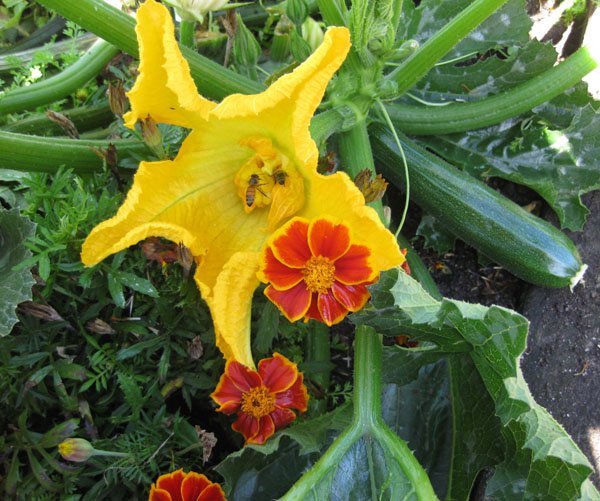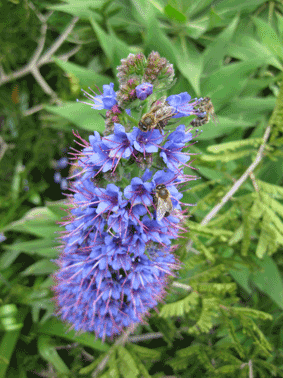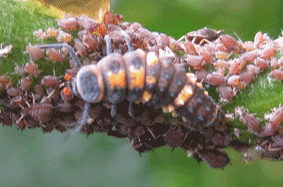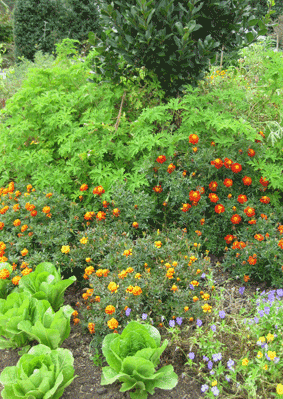Petal power
Every now and then I give a talk on organic gardening at a club or show. Afterwards I’m often approached with the question “do flowers have a place in the vegetable garden?” This is usually posed in an innocent fashion by one half of a couple, but with an obvious agenda of ‘let’s settle this argument once for and for all’ trailing behind it.
I have been asked this many times over the years and answer it – hopefully tactfully – with a definite ‘yes’. I actually find it pretty absurd to separate flowers and vegetables in this way. It illustrates how our western cultural traditions can skew our view of the world around us.
Vegetable exile
The tradition of separate flower and vege gardens is an inherited one. Once upon a time only very wealthy people could afford purely decorative gardens. Vast green lawns were maintained by an army of gardeners down on their knees equipped only with clippers. Only the villagers had ‘cottage gardens’, a functional jumble of herbs, vegetables and flowers jammed into the available space.
The rise of the middle classes who liked to ape their supposed ‘betters’ saw gardens become miniature estates with vegetables exiled out of sight. I believe this is where the separation we now take for granted between vegetables and flowers first began and it is simply based on snobbery.
Any botanist would find this separation an artificial one, as they are all simply flowering plants. It is not even dividing the edible from non-edible, as you would understand if you have enjoyed stuffed zucchini flowers, red clover or jasmine tea or eaten nasturtium or calendula petals sprinkled through a salad. Cauliflower, as the name suggests, is a flower, while broccoli is a large flower bud. Beans, peas, tomatoes, zucchinis and pumpkins all have to flower first in order to produce a crop. If we want to save seed then the plants have to flower.
The question really being posed is ‘Does an ornamental flower have a place in the vege patch?’ So the debate is about useful plants as against those perceived as being purely decorative.
I usually avoid discussing whether beauty has a value sufficient unto itself, and instead simply suggest what flowers can bring to the vege garden in terms of practical value.
Good bugs
Beneficial, pest-controlling insects – good bugs for short – are an important part of pest control in the organic garden. The bugs that end up as part of their diet are pests you haven’t had to do anything about. These good bugs are so efficient that you may not even be aware that a pest has come and gone. How do you attract these free workers? Simply by feeding them.
Flowers are essential to feed most of the adult good bugs as they are mainly nectar feeders. Their young are the carnivores that munch their way through such insect pests as aphids.
So, planting flowers and herbs such as alyssum (sweet alice), cosmos, marigolds, Queen Anne’s Lace, coriander and gypsophila will improve the natural balance and reduce pest outbreaks. Good bugs such as tiny micro wasps, ladybirds, lacewings, hoverflies and tachnid flies will then be attracted to your garden. When you provide a plentiful food supply of year-round nectar for the good bugs they will live longer and reproduce more. Green Harvest has a seed mix for this purpose called ‘Good Bug Mix‘.
Flowers are also critically important in providing a nectar supply for bees, and bees currently need all the help they can get. Many crops, such as cucumbers, pumpkins and zucchinis, are completely dependent on bees for pollination. Bees don’t simply retire to a dark cupboard and hibernate when they have finished pollinating your vegetable crops. They require a stable nectar supply so they will be there the next time you need them.
Many flowers are multi-functional rather than purely ornamental. My personal favourite is red clover with its pretty deep pink flower balls. It has a nectar supply that attracts good bugs and bees. We usually have a jar of dried flowers in the pantry for herb tea. Being a legume, red clover fixes nitrogen to improve the soil and can be cut, like lucerne hay, as a sustainable, home-grown source of mulch. It is better behaved than white clover which can run all over the place. Instead red clover sits as a neat clump that is pretty enough to use as an edging plant or ground cover.
Living garden
Beyond all this practicality lies the question of why we want to garden organically. We have all seen gardens that are flat, single dimensional spaces, arid of life. There are thousands of them out there in suburbia, an expanse of turf with a row of rose bushes in a neat, manicured bed with bare exposed soil. There might be an occasional lizard sunning itself but very few other signs of life.
Being out in my vege garden with its exuberant mix of herbs and flowers, annual and perennial vegetables and native flowering shrubs is the best part of my day. I can hear the buzz of the bees on the sunflowers and the thyme, see the hoverflies on the daisies, the quick flash of iridescent colour as a dragonfly darts over the pond. The croak of the frogs and the flitting of small birds in the grevillea all add to my sense of well-being.
The big difference between a productive garden with flowers like this and a vege-only garden in ordered rows is the life that the flowers bring to the garden. A garden without flowers is a sterile environment. To achieve an organic, resilient, sustainable garden there needs to be a place created for other forms of life and flowers are simply one of the best ways of doing this.
Tags: bees, flowers, fruit, insects, pest control, vegetables
Posted in Organic Gardening







Great information, thankyou. A good example of this is that last year both my sister and myself planted passionfruit vines in our backyards, this autumn saw our first flowers. She has fruit on hers at the moment as it is planted not far from grevillias(excuse my spelling please) and though I have had plenty of flowers on my vine during this autumn/winter my vine has not set any fruit. I will need I think to plant more flowers around that area of my garden.
This is a great article so simple and clear. I am going to stick it up on the fridge at Naganaga for all the people who ask me about this!
PS I love the blog